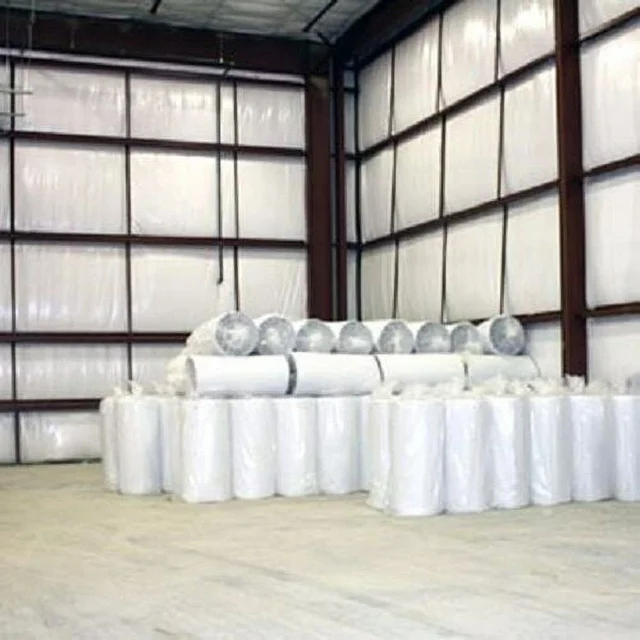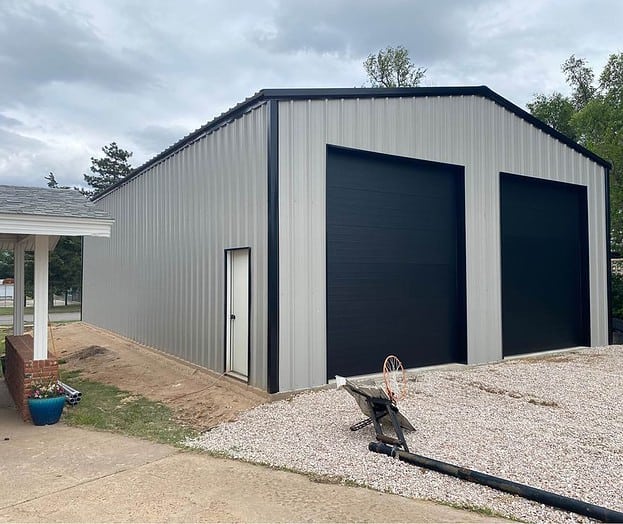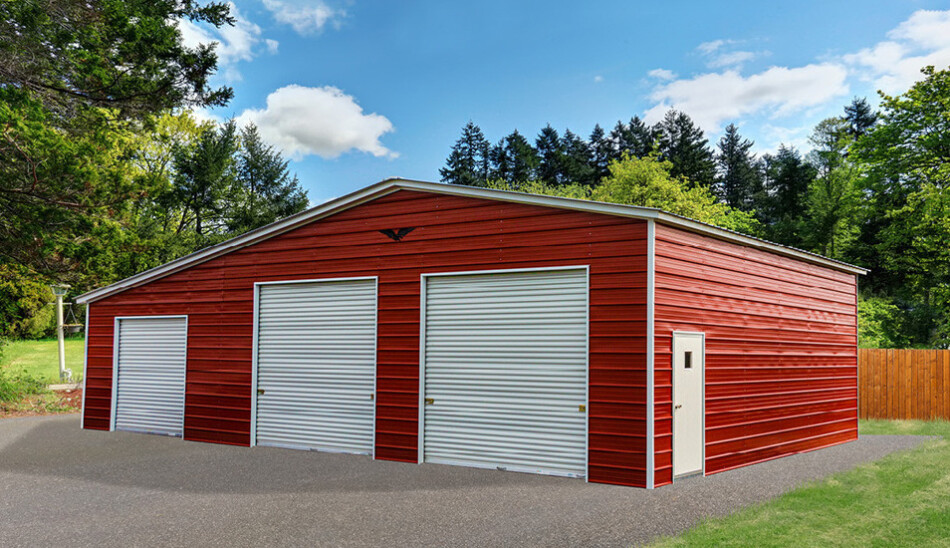Why Does My Metal Building’s Temperature Fluctuate?
Metal buildings are known for their durability and affordability, but they can also present unique challenges when it comes to temperature control. Here’s what you need to know:
Causes of Temperature Fluctuations:
- Metal’s Conductivity: Metal readily conducts heat, meaning it absorbs and releases heat quickly, leading to rapid temperature swings in response to outside conditions.
- Lack of Insulation: Older metal buildings often lack proper insulation, allowing unconditioned air to enter and escape, further exacerbating temperature fluctuations.
- Climate Extremes: Areas with hot summers and cold winters pose additional challenges, requiring dedicated heating and cooling systems for year-round comfort.
Solutions for Comfortable Temperatures:
- Invest in Quality Insulation: Proper insulation creates a thermal barrier, minimizing heat transfer and maintaining consistent indoor temperatures. Choose an appropriate insulation R-value based on your climate.
- Consider Insulated Metal Panels (IMPs): These panels offer pre-installed insulation for quick installation, weather resistance, and improved thermal performance.
- Install a Suitable HVAC System: Depending on your needs, choose a heating, cooling, or combined system to actively regulate temperature and humidity.
- Utilize Landscape and Ventilation: Strategic landscaping with shade trees and proper ventilation systems can passively cool your building and reduce reliance on active systems.

Additional Tips:
- Seal Air Leaks: Drafts and gaps around doors, windows, and other openings allow unconditioned air to enter, impacting temperature control and energy efficiency. Seal them thoroughly.
- Light Reflecting Colors: Painting your roof and exterior walls with light-reflecting colors can help deflect solar heat and reduce cooling demands.
- Programmable Thermostats: Optimize energy use and maintain comfort by installing programmable thermostats that adjust temperatures automatically.
Metal buildings experience humidity issues more frequently than traditional structures due to their inherent conductivity. This means they readily transfer heat, leading to temperature and moisture imbalances that trigger condensation. Here’s a breakdown of the key factors and solutions:
Causes of High Humidity:
- Temperature Differences: When warm, humid air comes in contact with the cooler metal surfaces, condensation forms. This is common in humid climates or when the building’s interior is significantly warmer than the outside.
- Poor Insulation: Inadequate insulation allows heat and moisture to pass through easily, exacerbating condensation and humidity issues.
- Insufficient Ventilation: Stagnant air traps moisture, creating a breeding ground for condensation. Proper ventilation promotes air circulation and removes excess moisture.
- Moisture Infiltration: Leaks, cracks, or gaps in the building envelope allow moisture to enter, contributing to high humidity levels.

Consequences of High Humidity:
- Corrosion: Condensation accelerates metal corrosion, weakening the structure and causing aesthetic damage.
- Insulation Failure: Moisture trapped in insulation reduces its effectiveness, impacting energy efficiency and thermal comfort.
- Pest Infestation: Damp environments attract pests, leading to additional building damage and hygiene concerns.
Solutions:
- Improve Ventilation: Install exhaust fans, open windows strategically, or consider mechanical ventilation systems for effective air circulation.
- Install Vapor Barriers: These membranes prevent moisture from entering the insulation, mitigating condensation buildup.
- Upgrade Insulation: Ensure sufficient insulation R-value for your climate and consider vapor-impermeable options to control moisture movement.
- Address Moisture Sources: Seal leaks, repair cracks, and improve drainage around the building to prevent moisture entry.
- Dehumidifiers: In particularly humid environments, dehumidifiers can be a temporary or supplemental solution to manage air moisture content.

Additional Tips:
- Monitor humidity levels: Invest in a hygrometer to track indoor humidity and identify potential problems early.
- Maintain proper airflow: Avoid blocking vents or air circulation paths with stored items.
- Dry wet spills promptly: Prevent moisture accumulation from accidents or spills.
- Consider professional advice: For complex situations, consult a building science professional for customized solutions.
Living and work areas aren’t the only facilities that benefit from insulation. By insulating your metal garage, you cut down the chances of water damage, and you can also preserve equipment in a weather-resistant facility.
Metal Building Temperature Fluctuations: Understanding the Causes and Solutions
While metal buildings offer advantages like durability and cost-effectiveness, managing their temperature can be a challenge. This guide will help you understand the reasons behind temperature fluctuations and explore effective solutions for a more comfortable and energy-efficient space.
Understanding the Culprits:
- Metal’s conductivity: Metal readily absorbs and releases heat, leading to rapid temperature swings in response to outside conditions.
- Lack of insulation: Older metal buildings often lack proper insulation, allowing unconditioned air to freely enter and escape, further exacerbating fluctuations.
- Climate extremes: Areas with hot summers and cold winters demand dedicated heating and cooling systems for year-round comfort.
Creating a Comfortable and Stable Environment:
- Invest in quality insulation: This creates a thermal barrier, minimizing heat transfer and maintaining consistent indoor temperatures. Choose an R-value suitable for your climate.
- Consider insulated metal panels (IMPs): These pre-insulated panels offer quick installation, weather resistance, and improved thermal performance.
- Install a suitable HVAC system: Depending on your needs, opt for a heating, cooling, or combined system to actively regulate temperature and humidity.
- Utilize landscape and ventilation: Strategic landscaping with shade trees and proper ventilation systems can passively cool your building and reduce reliance on active systems.
Additional Tips for Optimal Control:
- Seal air leaks: Drafts around doors, windows, and openings allow unconditioned air to enter, impacting temperature control and energy efficiency. Seal them thoroughly.
- Embrace light-reflecting colors: Painting your roof and exterior walls with light-reflecting colors helps deflect solar heat and reduces cooling demands.
- Optimize with programmable thermostats: Install programmable thermostats to adjust temperatures automatically, enhancing comfort and energy efficiency.
Remember: Consulting a professional can help you choose the most effective solutions for your specific needs and climate.
Conquering the Chill: Keeping Your Metal Building Warm

Metal buildings, while sturdy and cost-effective, can pose a unique challenge when it comes to maintaining comfortable temperatures. But fear not! Here’s a comprehensive guide to keeping your metal haven warm and toasty:
The Heating Hero: HVAC Systems
- Find the Right Fit: Choose an HVAC system that matches your building’s size and needs. Consider factors like square footage, climate, and intended use.
- Fuel Your Comfort: Explore various fuel options like electric, gas, or propane, depending on your budget and availability.
- Maintenance Matters: Regular maintenance ensures your HVAC system runs efficiently and effectively, saving you money and energy in the long run.
Insulation: Your Thermal Guardian
- Embrace the Upgrade: If your existing insulation shows signs of wear or dampness, replacing it is crucial.
- Spray Foam Savvy: Consider spray foam insulation for its excellent R-value and air sealing properties.
- High R-Value Homes in: Explore high R-value home insulation for effective heat retention. Remember, metal conducts heat quickly, so higher R-values are recommended.
- Fiberglass Caution: Avoid exposed fiberglass due to its flammability concerns.
- Double the Defense: Double bubble insulation acts as a moisture barrier, adding another layer of protection against the elements.
Wrapping Up: Preventative Measures
- Conquer Condensation: Condensation is your metal building’s nemesis. By addressing the points above, you can minimize its risk and protect your building from water damage and related issues.
- Teamwork Makes the Dream Work: Remember, an effective HVAC system and quality insulation work hand-in-hand for optimal climate control.
Bonus Tip: Consider adding radiant heaters for targeted warmth in specific areas, especially during colder months.
By following these tips and seeking professional advice if needed, you can transform your metal building into a warm and comfortable haven, regardless of the season. Feel free to ask if you have any further questions about specific aspects of keeping your metal building warm!
Contact Us For More Information
- Exceptional Customer Service: Experience the difference dedicated customer service and seamless customization can make.
- Contact Us Today: Explore the endless possibilities and unlock the potential of your property. Contact us today at 864-580-8589 or john@firstchoicecarports.com to discuss your unique needs.
- Sales service hours are Monday to Friday from 9:00 AM to 7:00 PM and Saturdays from 10:00 AM to 2:00 PM. Feel free to inquire about financing options.


